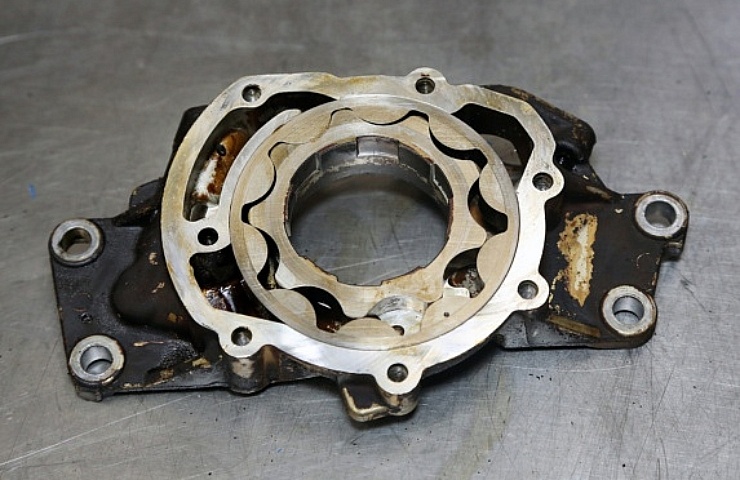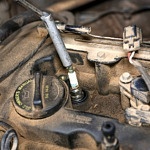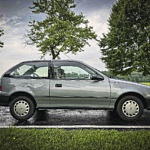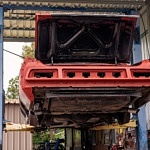Contents
Oil Pump Basics
The oil pump delivers lubricating fluid throughout the engine’s passages and galleries. It’s located either inside the oil pan, where it’s driven by the camshaft, or outside the pan with the crankshaft driving it.

OEM Subaru WRX STi oil pump
Oil is pulled from the pan and through a filter that removes debris before it enters the pump. Then, the pump pressurizes the fluid to move throughout the engine’s passageways.
There are two standard pump designs:

OEM Toyota 2JZ GTE oil pump
- Gear – This oil pump has two gears inside that create suction. As the gears rotate, the oil is pulled through the inlet into the pump. When the oil is pushed through the outlet, it is a pressurized fluid.
- Rotor – This oil pump uses an inner and outer rotor. The lobes of these rotors turn to pull the oil through the inlet and push it through the outlet as a pressurized fluid.
An oil pressure relief valve is found at the outlet of the pump to ensure the pressure remains within an appropriate range. The desired pressure is typically between 10 and 80 psi, but it varies by engine design.
Shop now for oil pumpsSymptoms of a Bad Oil Pump
An oil pump stops working due to mechanical failure or a lack of fluid. Within minutes, the engine can fail because of reduced oil pressure.
Here are a few symptoms to watch for:

Melling high volume Chevrolet LS V-8 oil pump
Dashboard Warning Lights
Engine sensors monitor oil pressure, and if it has dropped too low, the oil pressure warning light comes on. This problem may also signal the check engine light.
Low Oil Pressure
When a pump starts to fail, it can’t pressurize the oil. Without the right amount of pressure, engine components (crankshaft, camshaft, bearings, etc.) become starved of oil.

Boundary Ford Coyote V-8 oil pump
Engine Noise
If the engine isn’t getting enough oil, strange sounds follow. You may hear ticking, tapping, rattling, or knocking sounds, depending on the condition. All of these noises should be taken seriously.
Vehicle Doesn’t Start
Without the right amount of oil pressure, the engine may not start. Some vehicles automatically cut fuel delivery when there’s not enough oil pressure in order to protect the engine.
Shop now for oil pumpsHow to Replace an Oil Pump
Replace the oil pump on your own only if you have an advanced knowledge of mechanics. This job is beyond the scope of the home mechanic who normally handles regular maintenance.
Here are the typical pump replacement steps:
- Disconnect the negative battery terminal.
- Raise the front of the vehicle with your floor jack.
- Secure the vehicle on jack stands.
- Drain the oil.
- Remove the serpentine belt.
- Remove the oil pan bolts.
- Remove the oil pan.
- Remove the bolts holding the oil pump to the crankcase or block.
- While holding the oil pump that’s driven by the crankshaft, press the tensioner to create slack in the timing chain so the pump is freed.
- Clean off the surfaces with brake cleaner.
- Install the new oil pump and tighten the bolts to factory torque specs.
- Reinstall the timing chain on the pump driven by the crankshaft.
- Hold the oil pan in place while hand-tightening the bolts.
- Fill the engine with the appropriate amount of oil.
Carefully lower the vehicle back to the ground. Start the engine and run it briefly while you listen for any strange sounds. Turn off the engine, check for leaks, and double-check the oil level before driving anywhere.
The average cost to replace an oil pump is between $100 and $450 if you do the work yourself, although it varies by the type of vehicle. You may spend from $450 to $1,500 to have a professional mechanic replace the oil pump.
Oil Pump Maintenance
Regular car maintenance is essential if you want the oil pump to last as long as possible. Here are some tips to keep the oil pump in good condition.
- Perform regular oil changes so the pump remains free of debris.
- Replace the oil filter.
- Monitor oil pressure and stop driving if it falls below the normal parameters.
- Watch for leaks, which can cause engine damage. Fix any leaks at the first sign of trouble.





